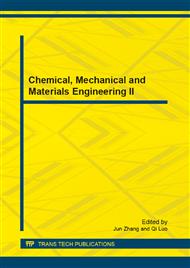p.213
p.219
p.227
p.233
p.239
p.245
p.249
p.257
p.263
Refining Energy Consumption and Fiber Development on CMC-Pretreated Poplar APMP
Abstract:
The aim is to get new information about the main energy consumption in where of refined poplar APMP fiber with CMC pretreatment. In this paper, PFI refining trials on 1% and 2% CMC-pretreated poplar APMP were conducted using a comparable standard process. In this process, the standard energy consumption linearly increased with PFI revolutions, CMC pretreatment changed the linear relationship and a plateau of energy consumption was shown against PFI from 2500 rev and 3000 rev. Moreover, the refined fiber was analyzed by a Fiber Lab Analyzer Kajaani FS300. the conclusion on energy consumption was that the energy consumption was mainly used in fiber straighten within PFI rev. 1000; During PFI rev. from 1000 to 2750, the energy demand was mainly used in fines and vessel increase; PFI rev. from 2750 to 3000, the energy consumption was used for fiber coarseness increase and fiber kink index decrease.
Info:
Periodical:
Pages:
239-244
Citation:
Online since:
May 2013
Authors:
Price:
Сopyright:
© 2013 Trans Tech Publications Ltd. All Rights Reserved
Share:
Citation:


